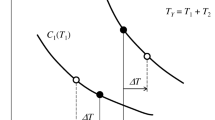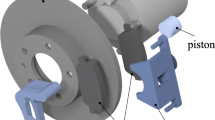Abstract
A tolerance synthesis provides the distribution of tolerances on the functional specifications of parts for a mechanism, with the objective of satisfying a set of functional requirements. This approach involves adjusting the nominal dimensions of parts. The present article offers a six-step solution within an Excel solver environment. The designer is able to control the optimization process using a dashboard. The initial steps detect conflicting requirements and suggest compromises, while the subsequent steps optimize the nominal part dimensions in order to maximize mechanism quality with minimum tolerance. The final steps then seek to maximize tolerances with the aim of minimizing costs. The proposed method can also manage specifications with both maximum and minimum material requirements.
Similar content being viewed by others
References
Ballu A, Mathieu L (1999) Choice of functional specifications using graphs within the framework of education, 6th CIRP CAT seminar. Kluwer, Enschede, pp 197–206
Marguet B, Mathieu L (2001) Method for geometric variation management from key characteristics to specifications. In: 7th CIRP CAT Seminar, Cachan, France, pp 121-131
Islam MN (2004) Functional dimensioning and tolerancing software for concurrent engineering applications. Comput Ind 54(2):169–190. doi:10.1016/j.compind.2003.09.006
Skowronski VJ, Turner JU (1997) Using Monte Carlo variance reduction in statistical tolerance synthesis. Comput Aided Des 29(l):63–69. doi:10.1016/S0010-4485(96)00050-4
Nigam SD, Turner JU (1995) Review of statistical approaches to tolerance analysis. Comput Aided Des 27(1):6–15. doi:10.1016/0010-4485(95)90748-5
Loof J, Hermansson T, Sodderberg R (2005) An efficient solution to the discrete least cost tolerance allocation problem with general loss functions. In: Davidson JK (ed) Model for computer aided tolerancing in design and manufacturing. Springer, Heidelberg, pp 115–124
Kurlarni SV, Garg TK (1987) Allocation of tolerances to the components of an assembly for minimum cost. Int J Mech Eng 67:126–129
Dantan JY, Mathieu L, Ballu A, Martin P (2005) Tolerance synthesis: quantifier notion and virtual boundary. Comput Aided Des 37(2):231–240. doi:10.1016/j.cad.2004.06.008
Etienne A (2006) An improved for automatic process plan generation of complex borings. Comput Ind 57(7):663–675. doi:10.1016/j.compind.2006.03.002
Shan A, Roth RN (2003) Genetic algorithms in statistical tolerancing. J Math Comput Mod 38:11–13. doi:10.1016/S0895-7177(03)90146-4 1427–1436
Anselmetti B (2006) Generation of functional tolerancing using positioning features. Comput Aided Des 38(8):902–919. doi:10.1016/j.cad.2006.05.005
Medhi-Souzani C, Anselmetti B (2008) Integration of automatic functional tolerancing into the design process. IDMME-Virtual Concept, Beijing (China), CD ROM paper no. 41, p 9
Anselmetti B, Mawussi K (2003) Computer aided tolerancing using positioning features. J Comput Inf Sci Eng 3(1):15–21. doi:10.1115/1.1565074
Anselmetti B (2007) Calcul tridimensionnel de la résultante d'une chaîne de cotes en cotation ISO, en vue d'un calcul probabiliste. Rev Méc Ind 8:173–185. doi:10.1051/meca:2007036
Anselmetti B (1996) Intégration des fonctions conception et fabrication en CFAO : traitement de la cotation. In: CIMAT’96, 5eme conférence Internationale de Rensenlaer sur la productique. INPG, Grenoble, pp 29–31
Anselmetti B, Mawussi B, Mejbri H (2001) Synthesis of tolerances starting from a fuzzy expression of the functional requirements. In: 7th CIRP CAT Seminar, Cachan, France, pp 265–274
Anselmetti B (2008) Cotation fonctionnelle tridimensionnelle et statistique. Hermes Lavoisier, Nantes
Tessendier D, Couetard Y, Gerard A (1997) Three-dimensional functional tolerancing with proportional assembly clearance volume (UPEL): application to setup planning. In: 5th CIRP Seminar on CAT, Toronto, pp. 113–123
Gaunet D (1994) Modèle formel de tolérancement de position. Contributions à l'aide au tolérancement des mécanismes en CFAO. Ph.D. thesis, ENS de Cachan
Clozel P, Rance PA (2007) MECAmaster: un outil de simulation des assemblages dès la conception préliminaire, approche industrielle, in Hermes, Tolérancement géométrique des produits.
Luneau F, Canal F, Clozel P (2003) Tolérance 3D: airbus applique la méthode 3A avec un outil de chaîne de cotes 3D. Rev Int CFAO Inform Graphique 18(1):37–60
Pillet M, Samper S, Formosa F (2005) Geometrical inertial tolerancing. In: 6eme congrès Int pluridisciplinaire Qualita 2005, Bordeaux, pp 757, 764
Adragna PA, Pillet M, Samper S, Formosa F (2007) Inertial tolerancing applied to 3D and form tolerancing with the modal analysis. In: 10th CIRP CAT seminar Erlanger, Germany (CD ROM)
Siarry P (2003) Méthaheuristiques pour l'optimisation difficile. Eyrolles, Paris
Author information
Authors and Affiliations
Corresponding author
Rights and permissions
About this article
Cite this article
Anselmetti, B. Part optimization and tolerances synthesis. Int J Adv Manuf Technol 48, 1221–1237 (2010). https://doi.org/10.1007/s00170-009-2355-6
Received:
Accepted:
Published:
Issue Date:
DOI: https://doi.org/10.1007/s00170-009-2355-6




